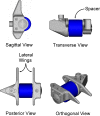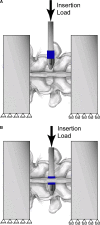Insertion loads of the X STOP interspinous process distraction system designed to treat neurogenic intermittent claudication
- PMID: 15926059
- PMCID: PMC3489454
- DOI: 10.1007/s00586-005-0891-9
Insertion loads of the X STOP interspinous process distraction system designed to treat neurogenic intermittent claudication
Abstract
An interspinous process implant has been developed to treat patients suffering from neurogenic intermittent claudication secondary to lumbar spinal stenosis. As most patients who suffer from spinal stenosis are over the age of 50 and may have weaker bones, it is imperative to know how bone mineral density (BMD) correlates with lateral spinous process strength. The study was undertaken to characterize the lateral failure loads of the spinous process, correlate the failure loads to BMD, and compare the failure loads to the loads required to insert an interspinous process implant. Spinous process lateral failure loads were assessed, correlated to BMD, and compared to the loads required to insert an interspinous process implant. Mean spinous process failure loads were significantly greater than the lateral insertion load of the interspinous process implant. There was a significant relationship between the BMD and spinous process failure load. The technique used to insert the interspinous implant poses little risk to spinous process failure. There is ample margin of safety between the insertion loads and spinous process failure loads. The significant relationship between BMD and spinous process failure load suggests that patients with lower BMD must be approached with more caution during the implant insertion procedure.
Figures





References
-
- Amundsen T, Weber H, Lilleas F, Nordal HJ, Abdelnoor M, Magnaes B. Lumbar spinal stenosis. Clinical and radiologic features. Spine. 1995;20:1178–1186. - PubMed
-
- Arbit E, Pannullo S. Lumbar stenosis: a clinical review. Clin Orthop. 2001;384:137–143. - PubMed
-
- Coe JD, Warden KE, Herzig MA, McAfee PC. Influence of bone mineral density on the fixation of thoracolumbar implants A comparative study of transpedicular screws, laminar hooks, and spinous process wires. Spine. 1990;15:902–907. - PubMed
-
- Drummond D, Guadagni J, Keene JS, Breed A, Narechania R. Interspinous process segmental spinal instrumentation. J Pediatr Orthop. 1984;4:397–404. - PubMed
-
- Gunzburg R, Szpalski M. Lumbar spinal stenosis. Philadelphia: Lippincott Williams & Wilkins; 2000.
MeSH terms
LinkOut - more resources
Full Text Sources
Other Literature Sources
Medical
Research Materials

